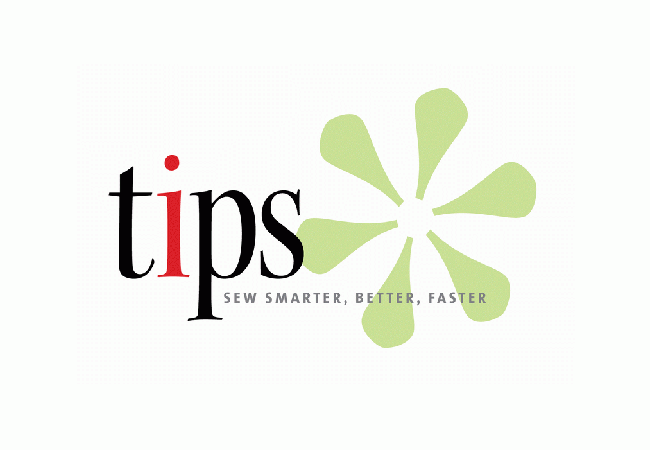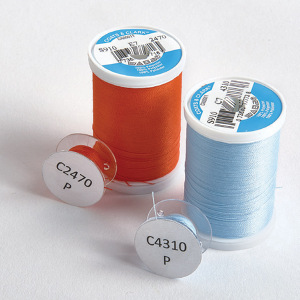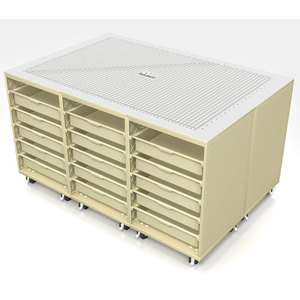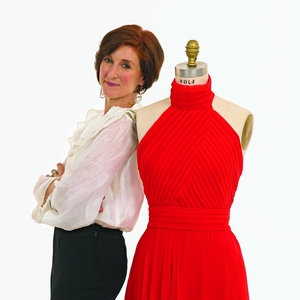
Send us your tips and they might appear in an upcoming issue of Quick Stuff to Sew.
It’s always satisfying to sew an intricate garment that takes time. On the other hand, there’s nothing like the instant gratification of sewing an outfit you can wear the same day.
With this thought in mind, we’re looking for helpful tips that make sewing quick and easy. Do you have a speedy way to thread a pesky needle, conquer difficult fabric, or fly through any other sewing steps? We’d love to hear your ideas. Post them here, and your tip could be selected to appear in an upcoming issue of Quick Stuff to Sew!
We pay for all the tips we publish.




































An easy way to add length to a hem of certain patterns is to stick Post-It notes to the hem of the pattern paper. That way, there is no need to cut the pattern paper to lengthen, and the pattern can be used again for someone who doesn't need length added.
Don't want to pin or hand-baste something??? Just don't have the time or energy to spend on basting??? Then GLUE IT!! Elmer's Washable School Glue Sticks are made for fabrics, among other things. And now it's in Disappearing Purple -- it goes on purple and dries quickly and colorless. It will wash out of clothes with normal laundering. It's readily available in the school supplies section of your favorite store and very inexpensive. Remember to try it on a scrap first before using on your real, beautiful project.
Speed in garment construction is easier to by serging. If your needle breaks when serging, there is no better tool to use for removing it than a bent-nose plier. This beading tool gives you the stability and accuracy you need to remove the broken needle in seconds.
Elissavet
When I buy new patterns I alos go to the Staples store and buy the Duck® Clear Laminate, 18" x 8 Yards. When I take my new pattern out of the package I cut each pattern piece out leaving as much room from the actual pattern print and tape it down on my table until it is nice and smooth then I laminate over the pattern and cut out the pattern on its biggest size.
If I need to have my pattern adjusted or sized I use packing paper that you can buy at Lowes or Home Depot or I even saw it at Walmart for about $10. I tape two pieces down on my table and put my pattern over and trace to the size I need.
Although it takes a couple of hours to get all this done, it is well worth it in the end and saves your patterns for someone else to use :-) Happy Sewing :-)
There was a tip from the Threada Magizine Aug. Sept. from Heather Langemann about using two colors to become a third. I LOVED IT.
I was reading the tips in the August/September issue and Heather Lamgemann had a tip "Two colors become a Third. I LOVED IT. as long as I have been sewing I have nevered put two threads in one needle especially two colors. I worked and I have been using this for the past week on different projects. Thanks for the Tip.
Jan Durfey
South Charleston Ohio
I like to keep several hand sewing needles threaded and ready to go, stuck in my pincushion, but when I brush against the dangling thread tails I often pull them right out of the needle.
To keep from unthreading the needles, I pull the thread all the way through so that the knot is right up against the eye of the needle. Then if I accidentally pull on the thread it doesn't go anywhere.
Scraps for feathered friends...
Last year I was laid off from my job and I moved to the Saginaw Bay nearby Lake Huron. I bought a new sewing machine to make blouses for my new job hunting. I picked up my first copy of “Threads” #139 to help me make my blouses more tailored because I hadn’t sewn in years. I was astounded at the results I had achieved. Every time I wore my blouses I was complimented.
My grandmother taught me to do hand embroidery when I was a little girl, and I wanted to try it again. So, I decided in my spare time to make my first quilt. I chose an appliqué design in predominantly honey gold and white. I hand-stitched silk and cotton embroidered flower pods with hundreds of French and Colonial knots. I then appliquéd them to the quilt blocks using the turned needle method.
There are seagulls, ducks, and song birds, on the dock and in the yard for me to watch while I sit and hand embroider. One spring day I saw a sparrow plucking lint from the clothes dryer vent at the side of the house. Immediately I knew it was collecting it to warm and line its nest for its new babies.
I found my grandmother’s favorite china teacup and started putting my tiny one, two, and three-inch scrap silk and cotton threads into the cup. When I had it full I dispersed it with some all-cotton batting so the tiny threads would not blow away in the wind. I tucked it all in the flagstone garden wall and wedged it between the stones. It is comforting to know that I helped the birds make fine silk and cotton nests this year because the temperatures were sometimes 20 degrees below zero. I am planning my next quilt and the birds will get all of my little snippits.
Here is a tip for smoother and easier easing for set-in sleeves making use of the different differential settings on a serger -- I do this instead of machine basting to create ease. Before sewing, finish the sleeve cap edge of your sleeve on your serger in the following way: serge with the normal differential setting from the edges to where the easing is. When you get to the easing area (between the notches), change the differential setting to a higher number (experiment on a scrap to see how much differntial you need). Change back to the normal differential setting when you leave the easing area and continue on to the other edge. The higher differential setting gathers the fabric smoothly. While serging, cut as little seam allowance off as possible. There is usually a little bit of fabric left to ease but that's easy to pin in before sewing in the sleeve.
My mother taught me hand embroidery when I was a kid. But it's been a long time anyine please tell me the way to do that...Thanks a lot in advance...
Brian
http://www.recoverybull.com
Recently I was struggling with finding my place in the sewing instructions. It felt as if I spent more time trying to relocate where my last step was,then actually sewing. I realized I needed a way to temporarily highlight my spot. I discovered that the glow tape I use for my ruler works beautifully for this. I just cut a strip a few inches long and laid it on top of the line of instuctions I was currently working on, then reposition it for the next step. works like a charm and I never lose my spot now.
Lynne williams
When sewing a project and you have layers and layers of fabric and interfacings that make it very difficult to put a pin through but you still need to hold in place? I have found the perfect solution for this problem. Metal paper holders. (I am not sure of the technical name for these holders)They come in all sizes, but the small ones work the best because you can position them where you want them. I am currently making the Travel Bag by Amy Butler, which also calls for piping. I have tried trimming out the heavy interfacing but it just makes the sewing process to unstable and the presser foot wants to slip off the fabric. I can't use pins they will just bend, so these metal paper holders work great.
i have found a company that supplies swedish tracing paper
in the uk with free shipping they are http://www.gloriarty.co.uk
there is also an address for usa
To keep buttons from falling off after sewing them on, I place a drop of fray check on the front of the button on the threads and also on the back threads over the knots. Holds buttons on tightly.
Turning a collar point? I use one of the threaded needles that I keep in my pincushion next to my serger/sewing machine. After stitching the collar in your favorite method, turn the corner right side out as 'tenderly' as you can. (I don't like to pull the corner out of shape) Then pick up your threaded (but UN-Knotted) needle. Now slip the needle through ONE side of the collar point as far into the point as you can stitch. I do the ACROSS the pointed end, not into the point. Pull the needle all the way through but stop when halfway down the length of thread. Now hold both ends of the thread and tug gently. Another bit of the point will come 'out' of the folds. When you think you have all you can, let loose of the thread and pull the needle all the way through. Turn the collar over and repeat on the other side. Repeat this action 3 or 4 times (it all takes maybe 1 minute), you will get a little less fabric each time and soon the point will be sharper than have ever done before.
I use a 24 x 30 inch "clean room sticky mat" at the entrance to my sewing room. This a basically a "tablet" of very thin tear-off sheets which are coated with a very sticky but non-transferring substance. On entering and exiting the sewing room, I take several steps on the mat, which traps and holds any household (entering) or sewing (exiting) debris. When the top sheet gets full and stops picking up what's on my shoes, I just tear it off and start on another sheet. The mats I use come in tablets of about 50. They're spendy, but at a about $1 a week, the price is well worth it to me. I like the 24 x 30 inch size because it fills the doorway threshold space so I can't step over or around it, and a full tablet is only about 3/8 inch thick, so its not a tripping hazard.
Search on "lab supplies", "clean room supplies" or simply "clean room sticky mat" to find a source. Find one that will sell you one tablet at a time. You don't need the "frame" they might try to sell you. I buy my tablets once a year (or less if I'm not sewing much) from U-Line, and they ship right to my door.
I greatly enjoy reading the tips in Threads. I do a lot of clothing alterations so any suggestions that you write about are very welcomed. I use a machine that has a short table so when I need a little extra room, I move my ironing board that has a rectangle piece of board on it to make it larger, over by my machine and put is the same height as the sewing table and now I have the extra room that I need. I also do a lot of up-cycling of fabrics and zippers that I take out of garments. It saves me money and and puts these items to another use.